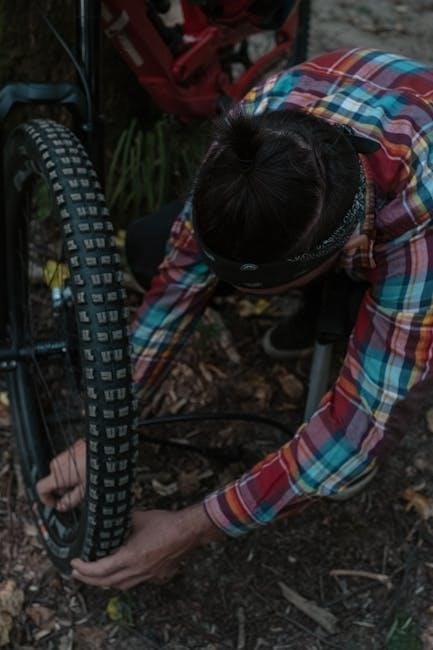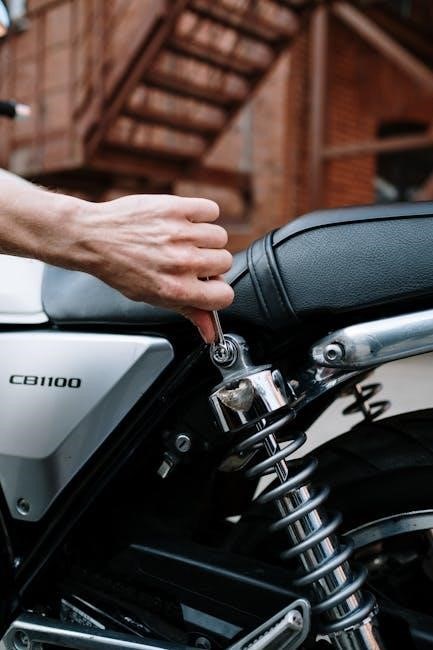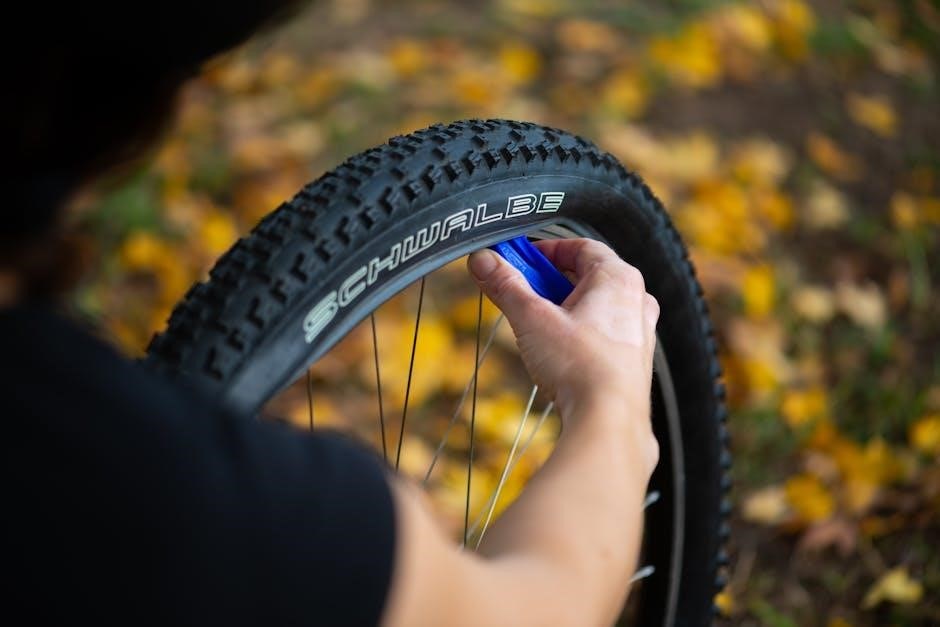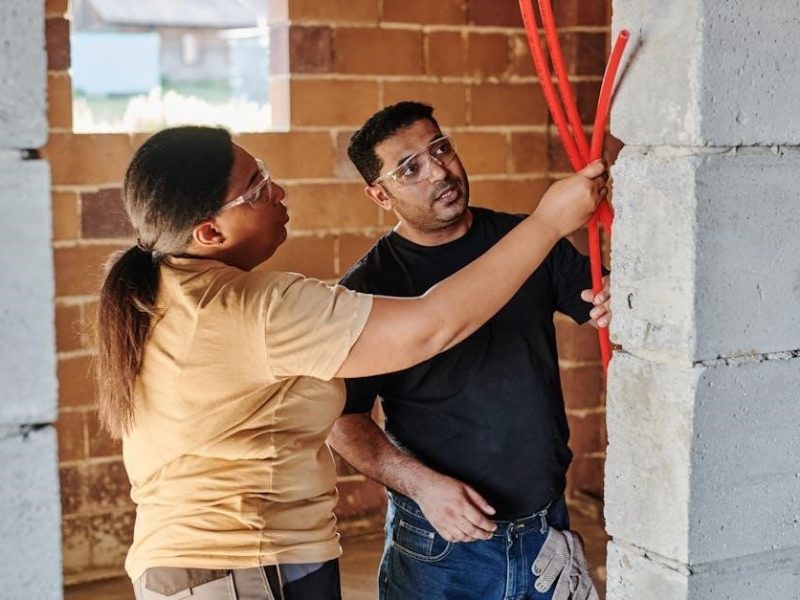The Ground Assault front bike suspension is a vital component for mountain biking, enhancing control and comfort. This manual guides users through setup, adjustment, maintenance, and troubleshooting to ensure optimal performance, providing a smoother ride by absorbing bumps and improving traction. Understanding proper setup and care is essential for maximizing the suspension’s effectiveness and longevity, ensuring a safer and more enjoyable riding experience.
1.1 Importance of Front Suspension in Mountain Biking
Front suspension is a critical component in mountain biking, playing a vital role in enhancing both comfort and control. Its primary function is to absorb shocks from uneven terrain, providing a smoother ride and reducing rider fatigue. By effectively managing bumps and vibrations, it allows the tire to maintain better contact with the ground, improving traction and braking efficiency. This results in improved handling and stability, especially on challenging trails. A well-functioning front suspension system enables riders to navigate technical sections with confidence, making it an essential feature for optimal performance and safety. Properly set up and maintained suspension ensures a more enjoyable and controlled riding experience across various terrains.
1.2 Overview of the Ground Assault Suspension System
The Ground Assault suspension system is designed to deliver exceptional performance and durability for mountain bikers. It features a robust construction with components tailored to withstand the demands of off-road riding. The system incorporates advanced technologies, including precise air pressure adjustment and reliable damping mechanisms, to offer a smooth and responsive ride. Key elements such as the fork, stanchions, and lower legs work together to absorb impacts and maintain stability. This system is user-friendly, allowing riders to fine-tune settings according to their weight and riding style. Regular maintenance, as outlined in this manual, ensures optimal functionality, prolonging the life of the suspension and maintaining its performance capabilities across diverse terrain conditions.
1.3 Purpose of the Maintenance Manual
The purpose of this manual is to provide riders with a comprehensive guide to understanding, maintaining, and troubleshooting their Ground Assault front bike suspension. It covers essential aspects such as assembly, adjustment, and repair, ensuring riders can keep their suspension in optimal condition. Regular maintenance, as outlined, helps prevent issues like leakage or stiffness. By following the manual, riders can enhance their bike’s performance, safety, and longevity, ensuring a smoother and more controlled ride. This guide empowers riders with the knowledge to maintain their suspension effectively, making every ride safer and more enjoyable.

Understanding the Front Suspension System
The Ground Assault front suspension system is designed to absorb shocks from uneven terrain, providing a smoother ride and improving control. It enhances traction and braking performance, ensuring optimal handling and rider comfort on various trails and conditions.
2.1 Key Components of the Front Suspension Fork
The Ground Assault front suspension fork comprises several critical components, including the stanchions, lower legs, and bushings, which work together to absorb shocks and maintain stability. The fork also features a spring or air chamber that provides the necessary resistance, along with damping adjustments to control compression and rebound. Additionally, seals and wipers are essential for preventing dirt and debris from entering the suspension system, ensuring smooth operation and longevity. Proper maintenance of these components is crucial for optimal performance and reliability, making them central to the overall functionality of the Ground Assault suspension system.
2.2 Suspension Travel and Sag: Definitions and Roles
Suspension travel refers to the maximum distance the fork can move to absorb impacts, while sag is the amount the fork compresses under the rider’s weight. Proper sag setup ensures optimal performance, as it allows the suspension to function within its designed range. Measuring sag involves comparing the fork’s fully extended position (F1) to its compressed position under rider weight (F2). The difference, known as free sag, should be set according to the manufacturer’s recommendations to balance comfort and control. Suspension travel and sag are critical for maintaining traction, reducing fatigue, and ensuring the bike handles terrain effectively. Adjusting these parameters correctly is essential for maximizing the Ground Assault suspension system’s efficiency and rider experience.
2.3 Types of Suspension Systems: Coil vs; Air
Mountain bike suspension systems are primarily available in two types: coil and air. Coil suspension uses a steel spring, offering consistent performance and durability, making it ideal for aggressive riding. Air suspension employs an air chamber, allowing for adjustable stiffness and lighter weight, suitable for varying rider weights. Both systems require regular maintenance to ensure optimal performance. Coil systems need less frequent adjustment but benefit from lubrication to maintain smooth operation. Air systems demand more meticulous care, including seal inspections and pressure checks, to prevent leaks and maintain proper function. Understanding the differences and maintenance needs of each type is crucial for maximizing the Ground Assault suspension’s efficiency and longevity, ensuring a superior riding experience with enhanced control and comfort.

Setting Up the Front Suspension
Properly setting up the Ground Assault front suspension involves measuring and adjusting sag, ensuring optimal travel for your weight and riding style. Follow the manufacturer’s guidelines for precise adjustments to achieve the best performance and comfort.
3.1 Measuring and Adjusting Sag
Measuring and adjusting sag is critical for optimal front suspension performance. Sag refers to the compression of the suspension under the rider’s weight. To measure sag, place the bike on a stand with the suspension fully extended. Record this measurement as F1. Next, have the bike on the ground without a rider and measure the fork’s compression, noted as F2. The difference (F1 ⸺ F2) is the free sag. Adjust the air pressure or spring tension to achieve the recommended sag setting, typically 20-30% of total travel. Proper sag ensures efficient absorption of shocks and maintains tire contact with the ground, enhancing control and ride quality. Always refer to the manufacturer’s guidelines for specific adjustments.
3.2 Recommended Sag Settings for Optimal Performance
Proper sag settings are essential for maximizing the performance of your Ground Assault front suspension. Sag should typically be set between 20-30% of the total suspension travel. For most riders, this translates to 15-25mm of sag on a 100-120mm travel fork. To achieve this, start by inflating the fork to the recommended pressure, then fine-tune in 10 psi increments. After adjusting, test the bike by riding it aggressively to ensure the suspension responds smoothly. Correct sag ensures optimal tire traction, reduces bottoming out, and maintains consistent handling. Always refer to the manufacturer’s guidelines for specific recommendations tailored to your bike model and riding style. Proper sag adjustment enhances both comfort and control, making it a critical step in suspension setup.
3.3 Adjusting Travel: Step-by-Step Guide
Adjusting the travel on your Ground Assault front suspension fork involves modifying the internal components to suit your riding style and terrain. Start by determining your desired travel using the manufacturer’s guidelines, typically ranging from 80mm to 140mm. Next, gather the necessary tools, including a shock pump, Allen wrenches, and travel spacers. Remove the fork from the bike and take out the air spring or coil. Add or remove travel spacers to achieve the desired travel, ensuring they are securely seated; Reinstall the spring, reassemble the fork, and bleed the system if needed. Finally, test the fork by compressing it fully to confirm the travel and adjust as necessary for optimal performance.

Regular Maintenance Routine
Regular maintenance ensures optimal performance and longevity of the Ground Assault front suspension. Clean the fork after each ride, lubricate moving parts every 25 hours, and inspect for wear.
4.1 Cleaning the Suspension Fork
Cleaning the suspension fork is essential for maintaining performance and longevity. Start by washing the fork with mild soap and water, avoiding high-pressure washes. Use a soft brush to remove dirt from stanchions and seals. Dry thoroughly with a clean cloth to prevent rust. Avoid harsh chemicals or abrasive materials that could damage components. Inspect for damage or wear during cleaning. Regular cleaning ensures smooth operation and prevents contamination. Recommended frequency is every 25 riding hours. Proper maintenance enhances suspension efficiency and rider safety.
4.2 Lubricating the Suspension Components
Lubricating the suspension components is crucial for maintaining smooth operation and preventing wear. Apply a water-resistant grease or silicone-based lubricant to the stanchions and moving parts. Ensure the fork is clean before lubrication to avoid contamination. Use a clean cloth to wipe away excess lubricant. Regular lubrication, ideally every 25 riding hours, prevents corrosion and reduces friction. Pay special attention to the seals and bushings, as they are prone to drying out. After cleaning or exposure to water, relubricate to maintain performance. Proper lubrication ensures optimal suspension function, enhancing ride quality and longevity. Always follow the manufacturer’s recommendations for lubricant type and application frequency.
4.3 Inspecting for Wear and Tear
Regular inspection of the suspension components is essential to identify wear and tear. Check the seals and wiper rings for cracks, tears, or excessive wear, as these can lead to leakage or reduced performance. Inspect the stanchions for scoring or pitting, which may indicate the need for refinishing or replacement. Examine the bushings for wear or play, as this can affect the fork’s alignment and smooth operation. Look for any signs of oil leakage around the seals or damping cartridge. Clean the fork thoroughly before inspection to ensure accuracy. If any significant wear is detected, replace the affected components promptly. Always follow the manufacturer’s guidelines for inspection and replacement to maintain optimal performance and safety.

Adjusting and Fine-Tuning
Adjusting the Ground Assault suspension involves customizing air pressure, compression, and rebound settings based on rider weight and terrain. Fine-tuning ensures optimal performance and ride quality.
5.1 Adjusting Air Pressure for Different Rider Weights
Adjusting air pressure in the Ground Assault front suspension is crucial for optimal performance. Start by measuring sag, the amount the fork compresses under the rider’s weight. With the bike on level ground, position the o-ring at the fork’s top and sit in your usual riding position. Disengage the brakes and compress the suspension, then release. The difference between the o-ring’s position and the fork’s top is the sag. For most riders, sag should be 20-30% of total travel. Use the fork’s pressure gauge to add or release air in small increments. Check sag after each adjustment. Refer to the manual for specific pressure recommendations based on weight. Proper air pressure ensures a responsive, controlled ride. Always test the suspension after adjustments to confirm optimal performance.

5.2 Tuning Compression and Rebound Settings
Tuning compression and rebound settings on the Ground Assault front suspension ensures optimal performance for varying terrain and rider preferences. Compression damping controls how the fork responds to impacts, while rebound damping regulates how quickly the fork returns to its neutral position. Start by setting compression damping to the manufacturer’s recommended baseline, then adjust in small increments based on ride feel. For rebound, begin with the mid-range setting and fine-tune to avoid excessive bounce or stiffness. Test adjustments on familiar terrain to gauge improvements in handling and control. Properly tuned compression and rebound settings enhance stability, reduce fatigue, and improve overall ride quality. Always refer to the manual for specific guidance tailored to your bike and riding style.
5.3 Fine-Tuning Suspension for Specific Terrain
Fine-tuning the Ground Assault suspension for specific terrain ensures optimal performance and adaptability. For cross-country riding, softer settings enhance comfort and efficiency, while firmer settings are better for high-speed descents. On technical trails, adjust compression to handle big hits and rebound to maintain traction. In muddy or loose conditions, reduce rebound damping to prevent excessive fork movement. For downhill or aggressive riding, increase compression to minimize bottom-out and maintain control. Always test adjustments on familiar terrain to ensure the bike feels balanced and responsive; Refer to the manual for terrain-specific recommendations and adjust in small increments to avoid overcompensation. Proper fine-tuning enhances stability, control, and overall riding confidence across diverse landscapes.

Troubleshooting Common Issues
Identify common issues like suspension leakage, noise, or stiffness. Inspect seals for leaks, check for loose parts causing noise, and service the fork if it feels frozen.
6.1 Diagnosing and Fixing Suspension Leakage
Suspension leakage is a common issue that can lead to reduced performance. Start by inspecting the fork for visible oil or fluid residue, which indicates a seal failure. Clean the area thoroughly to ensure accurate diagnosis. If leakage persists, inspect the seals and wiper blades for damage or wear. Replace damaged seals using a seal replacement kit specific to your Ground Assault suspension model. Lubricate new seals with suspension-grade grease before installation. After replacing, test the fork by compressing it several times to ensure the leak is resolved. Regular maintenance and prompt repair of leaks will prevent further damage and maintain optimal suspension function.
6.2 Resolving Noise or Clunking Sounds
Noise or clunking sounds from the suspension often indicate wear or improper lubrication. Start by cleaning the fork thoroughly, paying attention to the stanchions and lower legs. Inspect for debris or dirt that may be causing friction. Apply a high-quality suspension grease to moving parts, ensuring proper lubrication. If the noise persists, check the bushings and seals for wear. Worn components may need replacement. After servicing, compress the fork several times to test for improved performance. Regular lubrication and inspection can prevent such issues, ensuring smooth and quiet operation of the Ground Assault suspension system.
6.3 Addressing Stiff or Frozen Suspension
A stiff or frozen suspension can hinder performance and comfort. Begin by inspecting the fork for debris or contamination. Clean the stanchions and lower legs thoroughly using a soft brush and mild detergent. Apply a high-quality suspension grease to all moving parts, ensuring proper lubrication. If the issue persists, check the bushings and seals for wear or damage. Worn components may need replacement. After servicing, compress the fork several times to test for improved movement. Regular cleaning and lubrication can prevent stiffness, ensuring smooth operation. If the problem remains unresolved, consider professional servicing or consulting the manufacturer’s guidelines for advanced repair.

Advanced Maintenance and Repair
Advanced maintenance involves servicing lower legs, replacing worn seals, and bleeding hydraulic systems. These procedures ensure optimal performance and longevity of the suspension system.
7.1 Servicing the Lower Legs and Bushings
Servicing the lower legs and bushings involves thorough cleaning and lubrication to maintain smooth operation. Remove the lower legs and inspect for wear. Clean all surfaces with a mild solvent and apply a high-quality lubricant. Replace bushings if they show signs of wear or damage. Reassemble carefully, ensuring all components are properly aligned. Regular servicing prevents stiffness and ensures optimal performance. Always follow manufacturer guidelines for lubrication and replacement parts to maintain warranty and performance standards. Proper maintenance extends the life of the suspension system and enhances riding experience. Regular checks and timely servicing are crucial for consistent performance.
7.2 Replacing Seals and Wipers
Replacing seals and wipers is essential to prevent fluid leakage and maintain optimal suspension performance. Begin by removing the fork legs and inspecting for damage. Clean the area thoroughly before installing new seals, ensuring they are properly seated with a seal driver. Apply a thin layer of grease to the wipers and reassemble the fork. Cycle the suspension several times to test for leaks. Use manufacturer-recommended tools and parts to ensure a proper fit. Regular replacement of worn seals and wipers prevents dirt ingress and maintains smooth operation. This process is critical for preserving the suspension’s functionality and longevity. Always follow the manufacturer’s instructions for accurate installation. Timely replacement avoids costly repairs and ensures consistent performance on the trails.
7.3 Bleeding the Hydraulic System
Bleeding the hydraulic system is crucial for maintaining optimal performance and preventing air bubbles from forming, which can cause a spongy feel. Start by gathering a bleeding kit and hydraulic fluid. Remove the front wheel and clean the fork thoroughly. Attach the bleeding kit to the damper and reservoir, ensuring all air is purged. Slowly inject fresh fluid, allowing it to flow through the system without introducing bubbles. Reassemble the components and test the suspension by compressing it several times. Any residual air can affect performance, so repeat if necessary. Always consult the manufacturer’s manual for specific instructions tailored to your Ground Assault suspension model. Proper bleeding ensures smooth, consistent operation and extends the system’s lifespan. Regular maintenance prevents costly repairs and enhances ride quality.

Safety Precautions and Best Practices
Always wear protective gear and ensure proper tool usage during maintenance. Regularly inspect the suspension for wear and tear to prevent failure. Clean with eco-friendly products to minimize environmental impact. Follow manufacturer guidelines for optimal safety and performance. Prioritize rider safety with pre-ride checks to ensure all components function correctly. Maintain a clean workspace to avoid contamination of suspension parts. Use recommended lubricants and avoid over-tightening components. Schedule professional servicing if unsure about complex repairs. Keep the suspension system free from debris for consistent performance and longevity. Adhere to local regulations and ride responsibly, respecting the environment and other trail users. Regular maintenance ensures reliability and enhances the overall riding experience. Stay informed about updates and recalls for your specific Ground Assault suspension model. Proper storage and transportation of the bike prevent unnecessary strain on the suspension system. Educate yourself on basic first aid and emergency procedures in case of accidents. Familiarize yourself with trail rules and safety guidelines to minimize risks. Always test the suspension after servicing to ensure proper function before riding. Be mindful of weather conditions that may affect suspension performance and adjust accordingly. Keep essential tools and spares handy for trailside adjustments. Respect wildlife and other trail users to promote a safe and enjoyable environment for everyone. Stay within your skill level and gradually challenge yourself to avoid overwhelming the suspension system. Regularly check tire pressure and overall bike condition to complement suspension performance. Use proper lifting techniques to avoid injury when handling the bike. Avoid overloading the bike with excessive weight, as this can strain the suspension. Stay hydrated and energized during rides to maintain focus and control. Plan your route according to your fitness level and bike capabilities to avoid pushing the suspension beyond its limits. Carry a basic toolkit and emergency contacts for unforeseen situations. Familiarize yourself with the trail map to anticipate challenging sections and adjust your riding accordingly. Use lights and reflective gear for increased visibility during early morning or evening rides. Keep your phone accessible but secure to prevent distractions while riding. Be cautious of loose clothing or accessories that could get caught in moving parts. Stay alert for obstacles like rocks, roots, and puddles that may require sudden suspension response. Use proper body positioning to maintain balance and control, reducing stress on the suspension. Avoid sudden jumps or drops without proper experience, as this can damage the suspension. Keep your hands on the grips and maintain a firm but not overly tight hold. Use your body weight to help absorb impacts, working in harmony with the suspension. Practice braking techniques to avoid excessive stress on the front fork. Stay relaxed and maintain good posture to improve control and reduce fatigue. Be aware of changing trail conditions like mud or sand that can affect suspension performance. Use appropriate cleaning techniques to remove stubborn dirt without damaging the suspension components. Apply lubrication evenly and avoid over-lubricating, which can attract dirt and degrade performance. Inspect seals and wipers regularly for signs of wear or damage to prevent contamination. Use the correct torque specifications when tightening bolts to avoid stripping or over-tightening. Keep suspension fluids at recommended levels to ensure proper damping and prevent damage. Avoid mixing different types of hydraulic fluids, as this can compromise system performance. Use a clean, lint-free cloth when wiping down the suspension to prevent introducing contaminants; Inspect the suspension for any signs of rust or corrosion and address them promptly. Use rust-inhibiting coatings or lubricants to protect metal components from environmental factors. Regularly check the condition of bushings and bearings, as wear can lead to play or binding in the suspension. Use precision tools to avoid rounding bolt heads or damaging components during servicing. Keep all suspension parts organized during disassembly to ensure nothing gets lost or misplaced. Use a torque wrench to ensure bolts are tightened to the correct specification, preventing damage or loosening. Avoid using high-pressure washes, as they can force water into the suspension internals and cause damage. Use a soft-bristle brush to gently remove debris from intricate areas of the suspension. Apply suspension lube evenly and wipe off any excess to maintain optimal performance. Use a clean workspace to prevent cross-contamination of parts and ensure a precise servicing process. Keep the suspension fork upright during servicing to prevent fluid from spilling or migrating. Use a syringe or precision applicator for lubing small components to avoid waste and ensure accurate coverage. Inspect the suspension for any signs of dents or bends, as these can affect performance and safety. Use a truing stand to check and correct any misalignment in the suspension components. Avoid overheating the suspension during intense rides, as this can degrade hydraulic fluid and affect damping. Use a cooling pad or water to manage heat during prolonged descents or heavy use. Keep the suspension away from direct sunlight or extreme temperatures to prevent fluid degradation; Use a high-quality suspension cleaner that is safe for the materials used in your Ground Assault system. Avoid using household cleaners, as they may damage rubber or plastic components. Use a microfiber cloth to clean the suspension, as it is gentle and effective at picking up dirt and grime. Inspect the suspension for any signs of UV damage, such as cracking or discoloration, and replace affected parts. Use a suspension pump with the correct pressure range to avoid over-inflating or under-inflating the system. Calibrate your suspension pump regularly to ensure accurate pressure readings and consistent performance. Use a pressure gauge to double-check the settings recommended by the manufacturer for your specific suspension model. Avoid using compressed air to clean the suspension, as it can push debris further into the internals. Use a can of compressed air specifically designed for bike maintenance, with a controlled nozzle to direct airflow precisely. Inspect the suspension for any signs of pest or rodent damage, such as chewed wires or nesting material. Use rodent deterrents like peppermint oil or commercial repellents to keep pests away from your bike. Keep your bike in a dry, well-ventilated area to prevent moisture buildup and rust on metal components. Use a dehumidifier in your storage area to maintain a dry environment and protect your suspension from corrosion. Avoid storing your bike in extreme temperatures, as this can affect the viscosity and performance of the suspension fluids. Use a bike cover to protect your suspension from dust and debris when not in use. Regularly check the suspension for any signs of leakage or fluid loss, as this can indicate worn seals or damaged components. Use a clean rag to wipe down the suspension after rides to remove dirt and moisture. Inspect the suspension for any signs of impact damage, such as dents or scratches, and have it checked by a professional if unsure. Use a suspension service interval tracker to stay on top of regular maintenance and ensure optimal performance. Avoid riding aggressively if you’re unsure about the condition or setup of your suspension, as this can lead to accidents or damage. Use a suspension setup guide specific to your Ground Assault model to achieve the best performance for your riding style. Regularly update your suspension setup as your riding skills and preferences evolve to ensure continued comfort and control. Use a data collection tool or app to track your suspension performance and make informed adjustments based on your riding data. Avoid making drastic changes to your suspension setup without testing them in a controlled environment first. Use a buddy system when testing suspension adjustments, so someone is available to assist if needed. Inspect the suspension for any signs of fatigue or stress, such as cracks or excessive wear, and replace parts as necessary. Use a torque specification chart to ensure all bolts and fasteners are tightened correctly, preventing damage or loosening over time. Avoid using suspension components from other bikes, as they may not be compatible with your Ground Assault system. Use genuine replacement parts or high-quality aftermarket components approved by the manufacturer to maintain performance and safety. Regularly check the expiration date of your suspension fluids and replace them as recommended to prevent degradation. Use a fluid change log to keep track of when maintenance was performed and what products were used. Inspect the suspension for any signs of contamination, such as dirt or oil mixing with grease, and clean or replace parts as needed. Avoid using the wrong type of grease or lubricant, as this can compromise the suspension’s performance and longevity. Use a grease rated for high-temperature and high-stress applications to ensure durability and smooth operation. Regularly clean and lubricate pivot points to maintain smooth movement and prevent binding or creaking; Use a cable lubricant on any moving parts, such as the brake and gear cables, to ensure smooth operation and prevent corrosion. Inspect the suspension for any signs of cable rub or wear, and adjust or replace cables as necessary. Use a frame protection kit to prevent damage from cable rub
8.1 Essential Safety Checks Before Riding
Before every ride, perform a thorough safety check of your Ground Assault front suspension system. Inspect for any visible damage, leaks, or wear on components such as seals, wipers, and bushings. Ensure the suspension fork is fully extended and functioning smoothly. Check tire pressure and ensure proper sag settings according to your weight and riding style. Verify that all bolts and fasteners are tightened to the manufacturer’s torque specifications. Test the suspension by gently compressing it to ensure proper travel and rebound. Look for any signs of contamination or debris that may affect performance. Clean the suspension fork and lower legs to prevent dirt from affecting operation. Lubricate moving parts as recommended to maintain smooth function. Ensure the hydraulic system is free from air bubbles and that the damping settings are appropriate for your riding conditions. Always test the suspension on a safe, flat surface before heading out on the trail.
8.2 Proper Tool Usage for Suspension Maintenance
Using the correct tools is essential for maintaining your Ground Assault front suspension system. Always use high-quality tools like Allen keys, torque wrenches, and grease guns to avoid damaging components. A shock pump is necessary for air-sprung forks, while coil-sprung models may require spring compressors. Refer to your manual for specific tool recommendations. Clean tools before use to prevent contamination. Follow manufacturer guidelines for torque specifications to ensure bolts and fasteners are properly secured. Proper tool usage ensures effective maintenance, safety, and optimal performance of your suspension system.

and Final Tips
8.3 Environmental Considerations for Cleaning
When cleaning your Ground Assault front suspension, always use eco-friendly cleaning agents and biodegradable solutions to minimize environmental impact. Avoid using harsh chemicals that can harm local waterways or wildlife. Clean your bike on a surface that prevents runoff, such as a gravel or paved area, and dispose of waste materials responsibly. Use clean water sparingly and avoid cleaning near water sources. Properly contain and dispose of any lubricants orgrease to prevent contamination. By adhering to these practices, you can maintain your suspension while protecting the environment. Refer to your manual for specific guidelines on sustainable cleaning methods to ensure a responsible and eco-conscious approach to bike maintenance.


